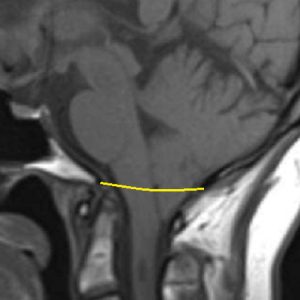Chiari 1.5 [C1.5m]
More of a clinical observation than an official type, Chiari 1.5 involves a herniation of BOTH the cerebellar tonsils AND the lower part of the brainstem (the medulla oblongata); both being below the foramen magnum.

A Chiari 1.5 (with the herniated medulla) is often indicative of something else causing the Acquired Chiari (not just the small posterior fossa).
- Cyst/Tumor pushing down from above
- Hydrocephalus or Intracranial Hypertension causing CSF to bear down from above
- Tethered Cord Syndrome (TCS) causing a pulling down on the spine from below (common amongst those with Chiari and a connective tissue disorder such as EDS)
- A CSF Leak creating a pulling/suctioning downward (also common amongst those with Chiari and a connective tissue disorder such as EDS)
*It is important to remember that most of these “causes” are not mutually exclusive; you can have more than one of the above and if you have a connective tissue disorder, the likelihood of having more than one increases.
BACKGROUND: Chiari 2 was once referred to as being with or without Spina Bifida. While they both include a hindbrain herniation and that of the brainstem as well, there are differences with the fourth ventricle also being herniated and the vermis (the nerve tissue that connects both halves of the cerebellum) being incomplete/missing. With a herniated brainstem, the malformation fails to meet the criteria for a Chiari 1, but without the fourth ventricle being herniated or the vermian hypoplasia, it fails to meet the criteria for a Chiari 2, the the Chiari 1.5 was defined to explain the growing number of patients that fall into this middle category.
OBSTACLES IN DIAGNOSIS/TREATMENT: It remains unknown by medical professionals. Most patients diagnosed with a Chiari Malformation are diagnosed with a Chiari 1 malformation with no mention of the position of the brainstem at all. When standard decompression surgery is performed, the causation is not addressed and is allowed to remain. Whatever may be pushing from above is still pushing from above; whatever may be pulling from below is still pulling from below; and the foramen magnum (the hole at the bottom of the skull) was just enlarged, providing an even larger area for the brain and brainstem to further herniate through. Therefore, while a measure of relief is initially obtained, it tends to be short-lived as the initial conditions that were never addressed cause further complications such as cerebellar slumping (brain sag) which recreates the initial problems with the blockage of cerebrospinal fluid.
Diagnosis Requirements: MRI showing the herniation consistent with a Chiari 0-1 accompanied by a low-lying brainstem where the medulla oblongata is fully or partially below the foramen magnum, without the fourth ventricle being herniated and incomplete/missing vermis AND if found, a full spine MRI should be done to rule out any other causes.
Treatment Options: Complicated. All other possible causes for the Chiari Malformation must be found and addressed, before, during, or soon after a decompression surgery.
Recommended Doctors: Neurosurgeon that specializes in complex Chiari Malformations.
